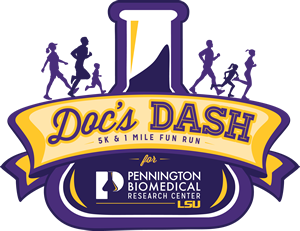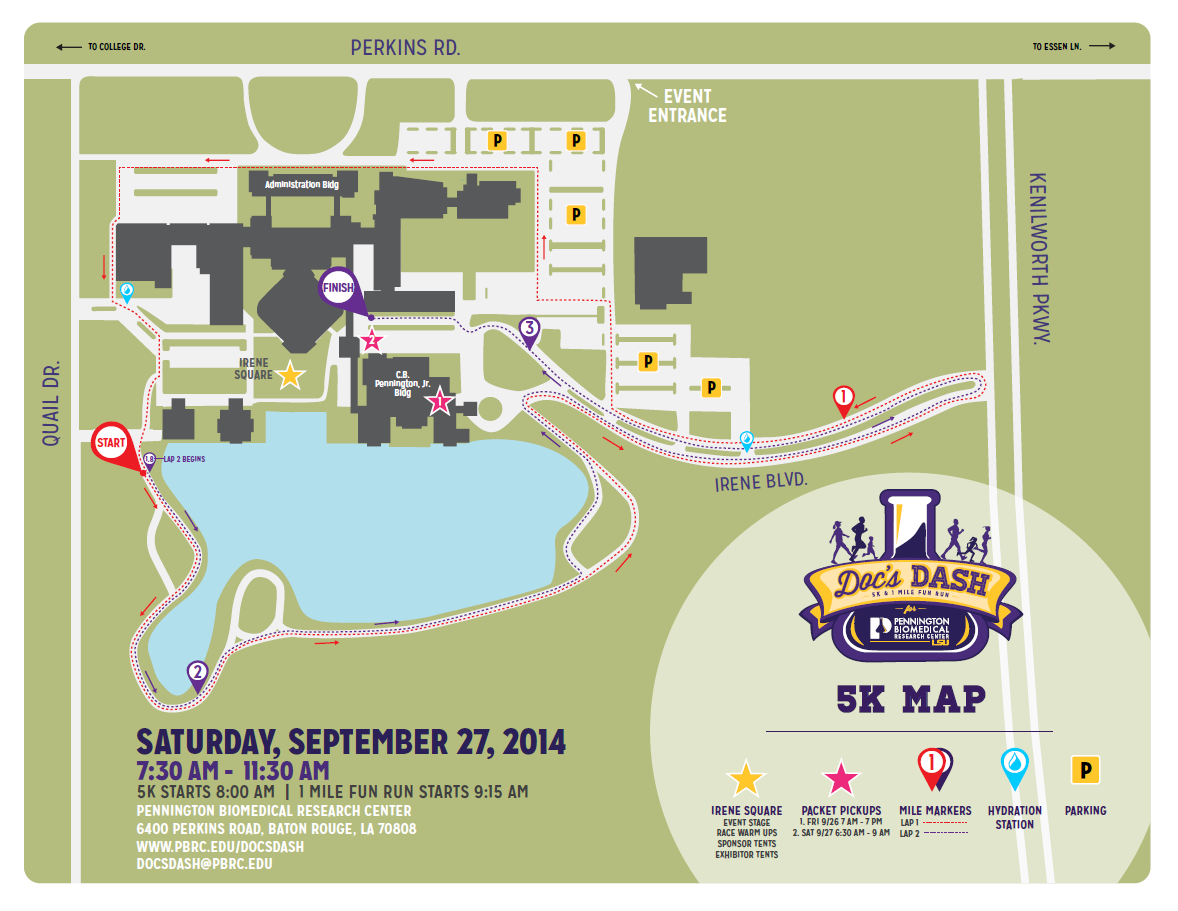Doc's DASH 5K Event Archives

Doc's DASH was an annual event benefiting the Pennington Biomedical Research Center. A campus of Louisiana State University, Pennington Biomedical is a world renowned research center that puts science to work for a healthier Louisiana.
Their discoveries have changed the way America eats, exercises and ages; and have advanced treatments for diseases from diabetes to obesity.

- 1 Mile Runners
- 1 Mile Walkers
- 5K Walkers
- 5K Runners Intermediate
- 5k Runners Advanced
- Stretching Guide
- Steps to Miles Conversion Chart
- Warm-up: A warm-up is meant to prepare the body for exercise by slowly raising your heart rate and increasing body temperature for flexibility. A warm-up can include light walking at a speed slower than your race pace, dynamic stretching, and/or marching in place.
- Talk Test: To measure exercise intensity during your cardio session, use a simple and effective technique called the “Talk Test.” The Talk Test has been validated through research to demonstrate that if someone can talk comfortably while exercising, then they're efficiently utilizing fat as a primary source of fuel. Once it becomes difficult to talk, this signifies that carbohydrates are a primary source of fuel for the activity. To perform this test, pick a phrase that takes approximately 20-30 seconds to say, such as the Pledge of Allegiance.
- Easy pace: Lightly walk or jog at a pace that allows you to easily maintain a conversation.
- Fast pace: Walk or run at a pace that may be difficult to maintain a conversation. This should be faster than your “normal” walking or running pace.
- Rate of Perceived Exertion Scale: “RPE” scale is used to subjectively measure the intensity of your exercise or one’s perception of effort. For example, if you’re exercising at a moderate intensity then you should be able to rate your effort at a 12 or 13 on the RPE scale. https://www.acsm.org/docs/current-comments/perceivedexertion.pdf
- Jogging vs. Running: Jogging and running differ with intensity. Jogging is a type of running that is done in a gentle, leisurely manner, whereas running requires more muscular endurance due to increase speed of the activity.
- Intervals: Interval training involves alternating short bursts of intense activity with what is called active recovery, which is typically a less-intense form of the original activity. The Swedes came up with a term for this type of training: fartlek, which means speed play. Not only is it an efficient training method, fartlek training can help you avoid injuries that often accompany non-stop, repetitive activity, and provides the opportunity to increase your intensity without burning yourself out in a matter of minutes. Unlike traditional interval training, fartlek training does not involve specifically or accurately measured intervals. Instead, intervals are based according to the needs and perceptions of the participant. In other words, how you feel determines the length and speed of each interval. Interval training allows you to enjoy the benefits of anaerobic activities without having to endure those burning muscles. In its most basic form, interval or fartlek training might involve walking for two minutes, running for two, and alternating this pattern throughout the duration of a workout.
- Long Run: A long run is an important part of any training. It provides muscular endurance and mental readiness for the body to complete the full distance of your race. Long walks or runs should be done at a comfortable pace. You should be able to carry a conversation with ease.
- Duration: The amount of time it takes to complete your activity.
- Distance: Distance is measured in miles or kilometers and is the physical length that is achieved during activity.
- Step conversions: The amount of steps you take each day can be converted to miles per day. Steps correlate to a person’s activity level: sedentary, low active, somewhat active, active, or highly active. See the chart.
- Cool-down: Cool-downs are used to restore equilibrium in the body and safely lower one’s heart rate. To perform a cool-down, jog or walk at a very slow pace and perform static stretching through total body range of motion. Static stretching gradually stretches your muscles to a point of mild discomfort. Hold each stretch for 10-30 seconds.
- Cross Training: Cross training uses several styles of training to develop a specific component of fitness. Cross training can include strength training, cycling, yoga, swimming, etc.
5K Course




